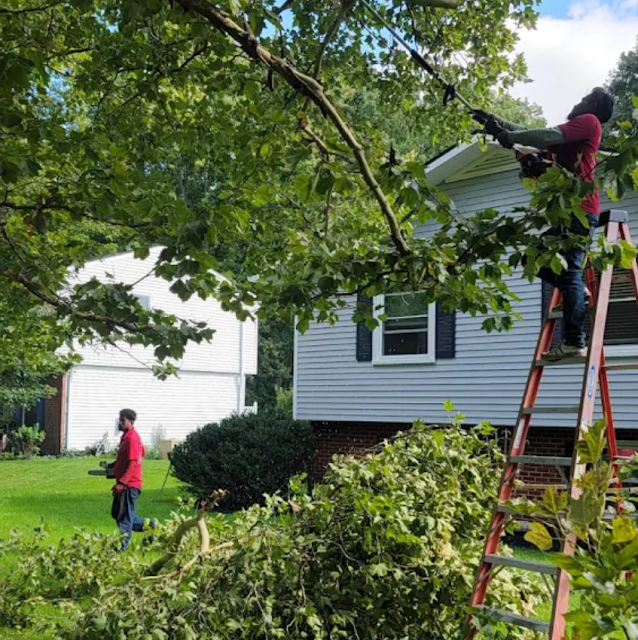Tree Trimming vs. Pruning: Understanding the Difference for Better Tree Maintenance in Buffalo NY
If you’ve ever wondered whether tree trimming and tree pruning mean the same thing, you’re not alone. Homeowners across Buffalo NY often use these terms interchangeably, but the truth is—there’s a big difference. Knowing when and why to trim or prune can make all the difference in the health, safety, and longevity of your trees.
So, whether you’re tackling seasonal Tree Maintenance Buffalo NY chores yourself or planning to call in a Certified Arborist, this guide breaks down what sets tree trimming and pruning apart and why both are critical to any well-rounded tree service Buffalo NY.
What is Tree Trimming?
In simple terms, tree trimming focuses on the aesthetics and shape of your trees and shrubs. Think of it like giving your trees a neat haircut to keep them looking tidy and balanced. Trimming removes overgrown branches that might be blocking sunlight or encroaching on walkways, roofs, or power lines.
In Buffalo’s residential neighborhoods, where mature trees frame historic homes and provide much-needed summer shade, regular trimming is essential. Overgrown branches can pose hazards during our heavy lake-effect snowfalls or sudden windstorms, making routine trimming a must for safety and curb appeal.
Trimming is generally done more frequently than pruning—often once or twice a year, depending on the tree species and its growth rate.
What is Tree Pruning?
Pruning, on the other hand, is all about your tree’s health and structural integrity. It’s a more selective process performed by a skilled Certified Arborist who understands which branches to remove for the overall wellbeing of the tree.
Pruning helps:
-
Remove dead, diseased, or pest-infested limbs before they compromise the entire tree.
-
Thin the crown to improve air circulation and sunlight penetration.
-
Encourage strong, healthy growth patterns that reduce the risk of storm damage.
-
Shape young trees for future strength and balance.
In short, pruning is a vital practice for tree longevity—especially in Buffalo NY, where winter ice storms can snap weak limbs and heavy snowfall can weigh down poorly maintained branches.
Why You Need Both: Tree Trimming and Pruning Work Together
While trimming and pruning serve different purposes, they complement each other perfectly when it comes to complete Tree Maintenance Buffalo NY.
Here’s a quick breakdown:
✅ Trimming keeps your landscape looking neat and safe by managing overgrowth.
✅ Pruning ensures your trees stay healthy, strong, and disease-free by addressing internal issues.
It’s a bit like regular haircuts versus deep conditioning treatments—both help maintain the health and appearance of your trees!
Common Questions: How Do I Know What My Tree Needs?
A lot of homeowners ask, “How do I know if my tree needs trimming or pruning?” The answer depends on several factors:
-
Visible Dead Branches: If you see dead or dying branches, it’s time to prune.
-
Blocked Sunlight: If your yard is too shady or grass won’t grow under your trees, they likely need trimming.
-
Unbalanced Growth: Leaning or misshapen trees may need corrective pruning to restore structural balance.
-
Encroaching Branches: If limbs hang too close to your roof, driveway, or power lines, trimming is needed immediately for safety.
A qualified Certified Arborist will inspect your trees and recommend a plan that balances trimming and pruning.
Why Hire a Certified Arborist for Tree Maintenance Buffalo NY?
Trees in Buffalo NY face unique challenges—lake-effect storms, wet spring seasons, and harsh winters all take a toll. That’s why it’s wise to call in local experts like Branch Specialists Tree Service Buffalo NY.
A Certified Arborist brings:
🌳 Expert Knowledge: Knowing exactly where and when to cut to encourage healthy regrowth.
🌳 Safety: Professional tree workers have the training and equipment to handle tall or hazardous trees.
🌳 Prevention: Spotting early signs of disease or pest issues before they spread.
If you attempt a large job on your own, you risk injuring yourself or your tree—sometimes both! Worse, incorrect cuts can make trees more susceptible to decay or storm damage.
When Should You Schedule Tree Trimming or Pruning?
Timing matters! In general:
-
Late winter to early spring is ideal for pruning most trees in Buffalo NY because they’re dormant, and cuts heal faster.
-
Summer or early fall is a good time for light trimming, especially to remove fast-growing shoots or overhanging limbs.
-
Emergency trimming or pruning can be done any time there’s storm damage or safety hazards.
And remember, sometimes trees can’t be saved. In those cases, safe tree removal Buffalo NY may be your best option.
A Word About Tree Removal
While this blog focuses on trimming and pruning, it’s worth noting that sometimes a tree becomes too damaged, diseased, or unsafe to keep. Tree removal Buffalo NY should always be handled by trained professionals, especially when large limbs hang near structures or power lines.
Final Thoughts: Keep Buffalo’s Trees Thriving
Buffalo’s tree-lined streets and historic canopy give our neighborhoods so much character. Proper trimming and pruning protect this urban forest for generations to come. If you’re unsure where to start, get an assessment from a trusted Certified Arborist who knows the local climate and tree species inside and out.
So next time you hear “trimming” and “pruning,” you’ll know: they’re both essential tools for maintaining healthy, beautiful, and safe trees in Buffalo NY.
Ready for Healthier, Safer Trees?
Whether it’s seasonal trimming, restorative pruning, or even safe tree removal Buffalo NY, the team at Branch Specialists Tree Service Buffalo NY is here to help you protect your trees—and your property.
For More Details to Know,



Comments
Post a Comment